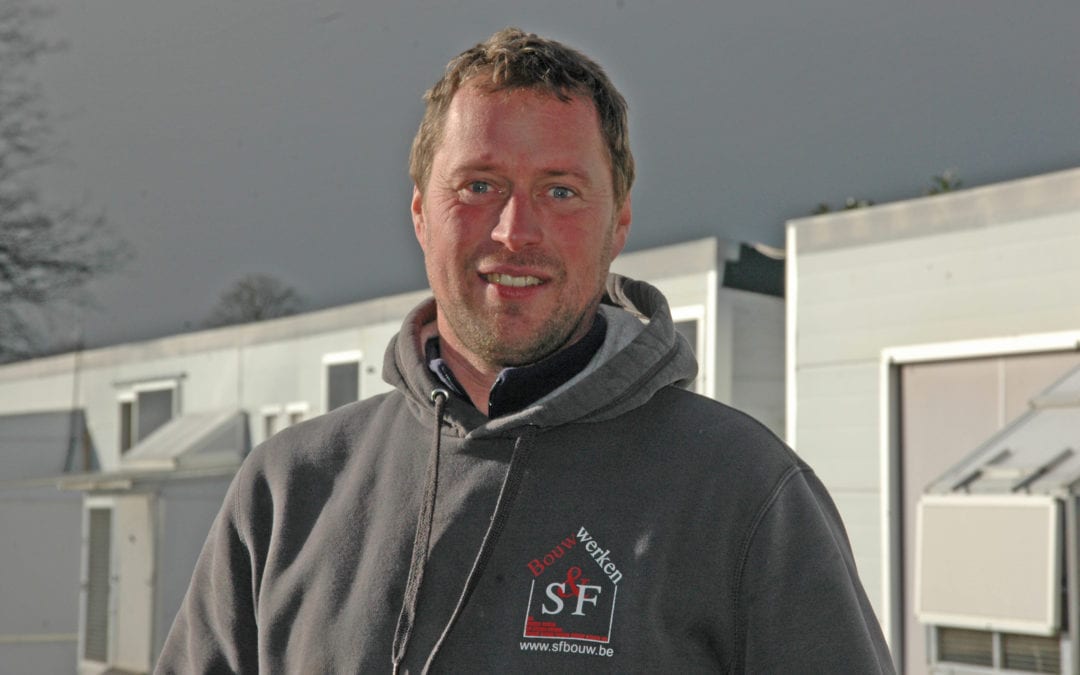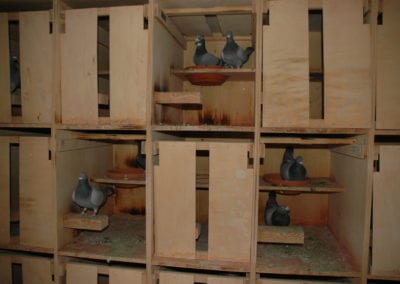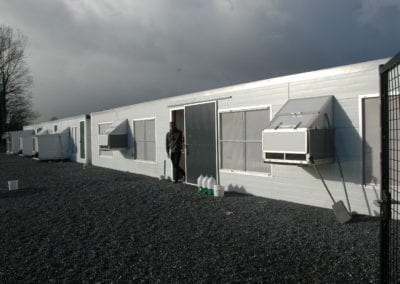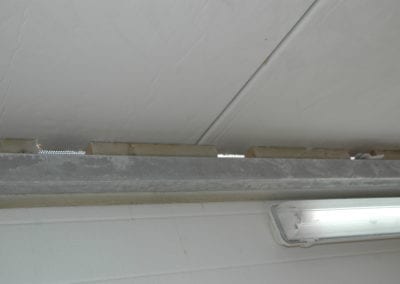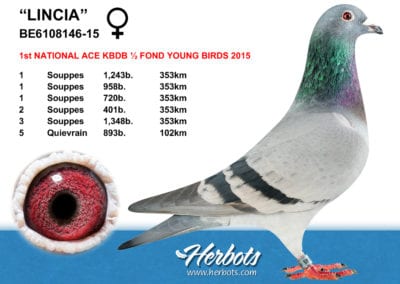STEFAAN LAMBRECHTS – NIJLEN
1st NATIONAL ACE BIRD KBDB MIDDLE DISTANCE YOUNG BIRDS 2018
7th AND 10th NATIONAL ACE BIRD KBDB MIDDLE DISTANCE YEAR BIRDS 2018
8th NATIONAL CHAMPION KBDB MIDDLE DISTANCE YOUNG BIRDS 2018
12th NATIONAL ACE BIRD KBDB MIDDLE DISTANCE YOUNG BIRDS 2018
Nijlen: Stefaan Lambrechts (41y) got international fame for the first time in 2015 when he won with his hen ‘Lincia’ the title of 1st National Ace bird KBDB Middle Distance Young Birds. Everybody spoke about a ‘strong and unique result’ as the coefficients were already very low and Stefaan managed to push his classful hen ‘Lincia’ to the top so she won the national title anyway. Out of Souppes-sur-Loing she won a.o. 1st /1,243b. – 2nd /2,391b. – 2nd /2,031b. And 3rd/1,348b. This was good enough for the lowest coefficient ever until the day of today.
Stefaan: “For many I was the rising star within pigeon sport but in fact I raced already really well on the short distance races for 30 years. Especially in the well-known ‘Diamant Verbond’ I knew to impress on a regular base, but those who race the short distance races are only known very locally. When I made the step towards the middle distance races it changed immediately.”
Stefaan… we see a nice range of lofts…all of them with a flat roof…specially overthought?
No, in fact not…when I bought this house in Nijlen in 2017 there were chicken lofts (out of concrete plates) in the garden. It was in the month of February and I couldn’t help myself to re-build these chicken lofts as quickly as possible to ween some youngsters on it. And honestly, totally unexpected it was immediately a hit in the rose. In the meantime these lofts were freshened up a bit and I’ve built according the same concept 40 meters more, divided over 10 departments. These are 8 departments for the young birds, 1 for the yearling hens and 1 for the yearling cocks. The walls and the ceiling are isolated and the aeration is limited, just a few openings just underneath the roof plate. All lofts are foreseen of sliding windows and with hot weather I can off course open these fully. Everywhere I’ve got wooden rosters on the floor and almost everywhere I’ve got boxes with conveyer belts for the manure, so in a matter of work I do spare a lot of time. In a matter of fact, when I look at my loft, it is built against many rules of how an ideal loft should be built, but well yes…the pigeons have good results on these lofts and that is the most important thing for me. At the moment I got a request at the township for expansion. So for all clarity, I still live in Berlaar where a part of my breeders reside but the racing team and another group of breeders are here in Nijlen. As I still have a lot of re-building to do on the house in Nijlen, this will be so for another few years.
Are we wrong when we state that you are a ‘young bird’s specialist’?
Oh…no… I do indeed like to race the young birds and even more many young birds. This is also the reason why I breed 300 youngsters for my own means. Nothing more exciting than having to wait for over the 100 pigeons from a middle distance race…it really gives me a kick. As I’m a full time professional pigeon fancier since 3 years now, I will also race old and yearling pigeons. In 2018 I had 30 yearling hens and 30 yearling cocks and those didn’t do badly either as they won a.o. the 7th and 10th National Ace bird KBDB Middle Distance Year Birds.
But this year you didn’t breed an early round of youngsters?
Indeed…crazy, eh. The consequence of my sale of all pigeons as from 2014 together with a group of about 200 pigeons from 2018. This sale was organized end of December and needed all of my attention, so I didn’t have time to couple end of November, beginning of December. I coupled mine, just as in the good old days with ‘Lichtmis’ (the weekend of the 2nd of February). These are about the same age then my former 2nd round, but I can do the necessary stunts with these as well. I will start a little bit later with the young pigeons. We’ll see…
Once the youngsters are weened…what’s next?
- When the youngsters are 21 days old they are weened. I like to ween early as I noticed that they can eat independent earlier and that they are way tamer. When they are older they get shyer.
- Once they are weened I won’t wait too long to vaccinate them against paramyxo. Not against tricho, I like to wait to cure them against tricho as long as possible.
- Every year my pigeons suffer from adeno. Mostly they get it when the 1st training flights are done. This is a very annoying period as I’ve got the habit to learn my youngster very intensively in a very short period of time. As I loose then about 14 days because the youngster are ill it is cursing for a while and adjusting the schedule. When the first signs of adeno are there, I immediately treat with a suitable antibiotic from a specialized vet. I always have this medicine ready at home.
- The first few months I try to keep my youngsters as calm as possible. It is not necessary that they are in the sky for an hour and take off immediately. To temper their lust to train I release them later in the afternoon and they get a breeding mixture to eat. The youngster can eat what they want but they still have to listen. In the morning they are being fed, but after 30 minutes the food is taken away from the loft. Between 15h and 16h they can go out and when they come in they again can eat how much they like.
- I believe it is important to learn them to drink in the basket. I put big travel baskets on the lofts and attach the known blue drinking cups. During an entire week they can run in and out the baskets so they are really well used to it.
- Once I see the youngsters are very eager to train, I will cure them against tricho and will start to toss them. The first toss is only at 1 km and I’ll do that until they stop being restless in the basket. Once the youngsters are calm in the baskets at 1km, I’ll go the mile and dare to toss them 2 or 3 times a day. You have to feel it a bit as a fancier if they can bare this training period well and if they do you can easily double the distance. If everything goes well, it is possible that they are in Quièvrain (110km) within 1 week.
- Whether I toss them during the season? No, not really….everything depends on the weather and the condition of the pigeons. Look…my opinion is that when they train well at home, it isn’t necessary to toss them, but I know myself and for my own good I do drive them once a week minimum 30km and maximum 70km.
- Half of July…about 14 days before the first national race out of Bourges, the sexes are being separated and the youngster will be raced on sliding doors. I used to have a loft for young birds on widowhood but as I like to race a lot of youngsters, the system with the sliding doors is the easiest and the most successful one. At the day of basketing I open the doors, I will go and get the baskets and I start to take them away. At home coming they can stay together until the evening, not overnight.
- Also every year they suffer ‘one-eye-cold’. I can expect this mostly when they are getting in shape. I already tried everything to beat this disease but until now I couldn’t find an effective medicine, so ‘sweating it out’ is the only rule.
- In a medical way I follow the rules of Dr. De Weerd Henk and Dr. Schroeder Vincent. These 2 vets live reasonably far away and that’s why I also visit Dr.Corteel during the season.
Stefaan…describe your schedule during one week in the racing season.
To avoid misunderstandings…the hens and cocks are being fed differently. Let me start off with the schedule of the hens. When the ladies come home on Saturday they get a bit of a candy mixture. In the evening they get all they can eat a fat rich mixture (Van Robaeys) enriched with oils and proteins from vet Schröeder. I also give them an obliged bath. On Sunday they only get a protein poor mixture in the evening. Not all they can eat but a small ration namely a little can of Zwan sausages (see picture) for 20 birds. As from Monday on until Wednesday they get “Lady Mix” (Van Robaeys). Again the same portion. On Thursday morning they get a racing mixture (one spoon per pigeon) and in the evening the mixture ‘Dynamic’ is on the menu. I always feed them first with well-set portions as there is oil mixed over it, after that they get ‘pure’ fat rich food and can eat all they want. Friday (day of basketing), at about 10 o’clock they can eat again all they want from the mixture ‘Dynamic’.
The cocks are being fed with a soup spoon and only get a light mixture on Monday. As from Tuesday they get directly a racing mixture and also get the ‘Dynamic’ mixture along the day of basketing approaches, just like the hens.
In a matter of side products they get electrolytes in the water. As mentioned before they get in the beginning of the week proteins over their food and on Tuesday it is ‘Extra Energy’ + ‘Conditional Powder’ + ‘Amino Forte’. On Wednesday this is ‘Extra Energy’ + ‘Conditional Powder’ + ‘Vita Tonic’ over the food. And as mentioned before, on Thursdays oil over the food.
Can you tell a bit more about your National Ace bird?
Well…there’s not a lot to tell. For a national ace bird middle distance you need 4 prizes and the first 4 middle distance races she raced it was already bingo. She was just ‘loose’ on the loft and wasn’t paired up. The band number of my Ace bird is B18-6156231 and got the name “Venus”.
She won the National Ace bird title with the following 4 top results: 2nd Chevrainvillers 1,645b. , 3rd Chevrainvillers 1,303b, 4th Melun 1,563b. And 5th Melun 902b. .
About her ancestors I can tell you the next:
Father: “B14-6091860”. He is also the father of “170-15” (14th prov. Gien 7,128b. – 72nd Souppes 1,619b. – 74th Noyon 1,327b. – 162nd Nat. Bourges 36,307b.). “
Grandfather: “Olympic 4000” (B09-6294000 – original Van den Bulck.) “Olympic 4000” won 32 prizes and is also grandfather of “Henkie J.” (10th Nat. Ace bird Middle Distance KBDB 2018), “Vroom” (9th Nat. Ace Bird TBOTB at Willem de Bruijn) and so on…)
Grandmother: “Daughter Montluçon” B08-6373646 – Dirk Van den Bulck/Jef Keirsmakers. Daughter to “112/03” (2nd Nat. Montluçon 11,568b. at Keirsmakers) x “558/04” (Sis 5th Nat. Souillac at Keirsmakers)
Mother: “B16-6081795”
Grandfather: “B14-6091891” – original Dirk Van den Bulck. Is also father to “Aure” (14th Nat. Ace bird short distance KBDB young birds). Is a son of “Blauwe Beer” ( won 1st, 1st and 2nd ace bird and comes out of “Broer Rode” x “4000-hen”) x “Half-sister Kittel”
Grandmother “Ynthe” B15-6108197 – 9th National ace bird KBDB middle distance youngsters – 50th Nat. Bourges 36,307b. – 5th Melun 1,779b. – 9th Souppes 2,031b. – 18th Souppes 2,391b. – 28th Souppes 3,342b.
Which strain of pigeons are the most successful once on your loft?
I entered my first loft list in 1987 with 4 pigeons and one year later I had 30 youngsters on my loft of 4 meters. These came from my uncles Cyriel and Emanuel Lambrechts. It was a super season.
But a lot changed in 2007…I bought pigeons at Jos Van Loock and Gert Heylen, both from Berlaar. A true valuable base couple “Blauwe Gert” x “Van Loock hen” was being baptised. In 2009 the first original Dirk Van Bulck pigeons were bought and these were strengthened with pigeons from Geert Lambrechts (Hallaar), Bart Hendrickx (Berlaar), Robin Van Leuven (Berlaar), Alex Dockx (Berlaar), Eric Volkaerts (Berlaar), Rudi Van Reeth (Herenthout) and Sylvain Verhestraeten (Herentals). In 2010 I again bought some new original Dirk Van den Bulck pigeons and the total stuck as butter on a sandwich.
Also other fanciers noticed this and came at my door to strengthen their own loft. This is how one of my pigeons became father of the 1st Olympiad Pigeon at Dirk Van den Bulck and she became on her turn mother of the world famous “Kittel” (1st Nat. ace bird short distance 2013). The big international acknowledgement came when I sold about 30 youngsters to Willem de Bruijn (Reeuwijk). My pigeons performed extremely well so other known Dutch top fancier as for example Eijerkamp, Herman Pouw and Kas Meijers came by to reinforce their own breeding loft.
But also on my own loft it still went crescendo. From 1987 until 2008 I only raced short distance races with young birds. As from 2009 I went weekly with a basket full of young pigeons to basket for a middle distance race and since 2017 I also started with year birds. My overview of titles in the national KBDB championships looks as underneath:
2010: 6th National ace bird KBDB short distance young birds
2011: 10tg National champion KBDB short distance young birds
2013: 2nd National ace bird KBDB middle distance young birds
2015: 1st National ace bird KBDB middle distance young birds – 9th National ace birds KBDB middle distance young birds – 14th National ace bird KBDB middle distance young birds2016: 14th National ace bird KBDB middle distance young birds – 9th Nat. Champion KBDB Short Distance young birds
2017: 4th National Champion KBDB Middle Distance Young birds
2018: 1st National ace birds KBDB Middle Distance Young birds, 12th National ace birds KBDB Middle Distance Young birds, 7th National ace birds Middle Distance KBDB Year birds, 10th National ace birds KBDB Middle Distance Year birds and 8th National champion Short Middle Distance KBDB.
Can you give a final advice to our readers?
Well… if it goes well you have to enjoy pigeon sport fully but when the results stay behind you even have to work harder as every detail counts.
Stefaan…thank you for you hospitality and we would like to wish you a lot of success!
Stefan Mertens
